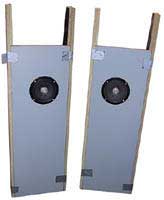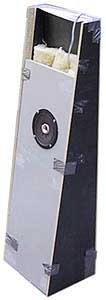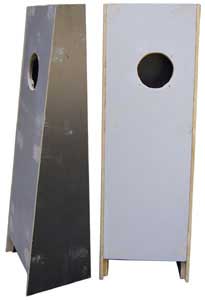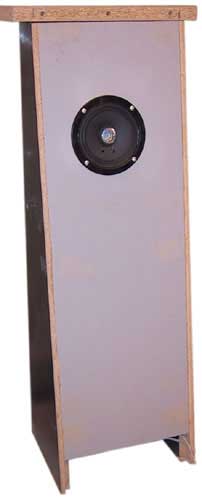|

Photo 1:
1st iteration in open
baffle w wings/legs
 
Photo
2:
2nd iteration in --
add a back

Photo
3:
3rd iteration in --
boxes glued up (no top or bottom yet)

Photo
4:
3rd
iteration in -- with driver and unsecured test top -- brick used to hold the top
down not shown
|
Another set of speakers
that was not designed but evolved (the Happy Ears School of Design).
It all started with the need for some cheap & nasty shop speakers. I choose the
least desirable set of drivers I had in my 2-buck-a-pair garage sale specials collection.
A very shallow 5" with an accordian surround and a little silver whizzer in
the middle. LearJet 8527.
Cut a hole in pieces of 3/4" scrap particle board**. No Bass. Add a pair of
angled sides out of 1" -- use duct-tape (every project needs a little duct-tape).
Set out on the apron of the garage listening to All Blues on KPLU -- these things
are really engaging.
Cut the dustcap out. Better. Do Marc Wauters 98 cent mod (or at least a crude variation).
Better. Add a piece of fiberglass just behind the driver. Better.
Next let's see what adding a back does. Lift the baffle 3" off the ground (note:
the duct-tape will not hold the baffle up for too long - see Photo 2). Better bass,
still engaging. Hasn't wiped out the mids.
Next glue the box together... duct-seal (actually plasticine in this case) the baskets
... way better bass... better everything else ... Top or no top? Add a top (photo
4) and hold it in place with a brick. That's good.
So next I need to shape the oak pieces from Mr. Miller and make (and attach properly!) a top.Then
it's on to detailing the stuffing. Then a oak base and cabinet detailing. Maybe even
a few measurements ;^)
Then Puzzlecoat and a phase plug.
Sort of a quasi-TQWP with size heading in the direction of a "Rhino".
* in Canadian dollars. Only includes price of drivers. Bits like screws, glue, wire,
draught exclusion strip probably brings actual cost to $5 CDN. YMMV
** cabinet material is rescued from the BFI bin of a local cabinet shop (where Chris works). The material is lower
density in the middle, denser as it goes toward the surface and finished in melamine.
The oak on the top and bottom was donated by a local Gary Oak.
|